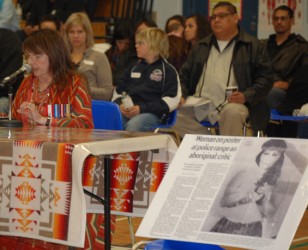Article Origin
Volume
Issue
Year
Tina (Dillon) Wolfe is still grieving the loss of her friend Violet Heathen. Heathen went missing in 2009. Heathen is one of more than 600 missing or murdered Aboriginal women and girls that the Native Women’s Association of Canada has documented.
“To this day, it’s still a cold case,” said Wolfe. Both women are from Onion Lake Cree Nation and both attended St. Anthony’s residential school.
“I always prayed they would find her killer.”
Canada has refused to heed the recommendation that came in September from the United Nations’ Human Rights Council to conduct a comprehensive review of violence against Aboriginal women, so Wolfe isn’t confident she, or Heathen’s family, will be getting answers any time soon. She is not surprised by Prime Minister Stephen Harper’s stand on the issue.
“He’s always been like that,” said Wolfe. “He’s never ever agreed to any terms. When it comes to our people, he’s more interested in helping the other people. I’m not talking racist. I’m just stating facts.”
The UN direction is just the latest received by the federal government. Last May, the premiers supported a call by Aboriginal leaders for a national inquiry into the issue surrounding missing and murdered Aboriginal women. A petition put forward by NWAC calling for such an inquiry has garnered 10,000 signatures and is to be submitted to the federal government in early December. But still Harper says no, insisting that the issue is better handled at the provincial and territorial levels.
Muriel Stanley Venne, president and founder of the Institute for the Advancement of Aboriginal Women in Edmonton, doesn’t agree.
“It isn’t fair to say that. (IAAW) has struggled first to bring the issue front and centre, which is very difficult when people already know and have avoided, and in fact determined, that there was nothing to do. I would see that what’s needed is a national plan to deal with the deaths of Aboriginal women, and where everyone is involved because it isn’t just the deaths of the women, it’s a persecution of a people,” said Stanley Venne.
She contends that governments, both federal and provincial, various human rights commissions throughout the country, including the Canadian Human Rights Commission, and other institutions have been aware of the high numbers of deaths and have kept silent for 40 years.
“I find it appalling that the Prime Minister of Canada does not recognize the deaths of our women … if it were any other racial group this would be a national issue and action would be taken,” she said.
Following the government’s refusal, an open letter was sent to Harper from the Assembly of First Nations, NWAC, and Amnesty International Canada, expressing “our collective and deep concern regarding the commitment of the federal government to end violence against Indigenous women and girls in Canada… We call upon you to provide unequivocal support to ensuring that Indigenous women and girls will have the protection and support needed to be free of violence.”
International Chief Wilton Littlechild, chair of the UN Human Rights expert mechanism on the rights of Indigenous peoples, says the issue of murdered and missing Aboriginal women and girls was a recurring concern brought to UN special rapporteur James Anaya on his recent visit to Canada. Indeed, Anaya emphatically supported a call for a national inquiry.
Photo caption: Muriel Stanley Venne’s presentation to the United Nations rapporteur included a poster of an Indigenous woman, once used by the Saskatoon Police for target practice. Stanley Venne would like to see the poster included in the Canadian Museum for Human Rights in Winnipeg.
- 11662 views

